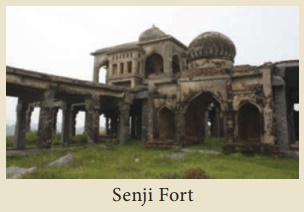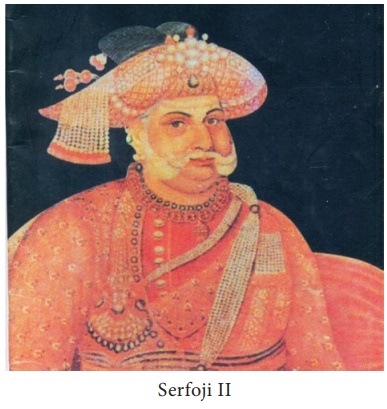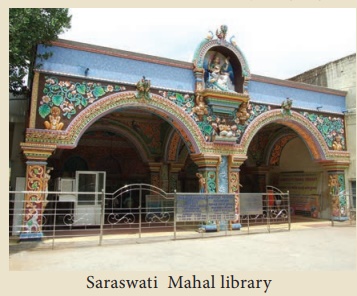The Marathas - Maratha Rule in Tamilnadu | 11th History : Chapter 15 : The Marathas
Chapter: 11th History : Chapter 15 : The Marathas
Maratha Rule in Tamilnadu
Maratha Rule in Tamilnadu
Circumstances leading to its establishment
Krishna Devaraya, during his reign (1509-1529),
developed the Nayankara system. Accordingly, the Tamil country was divided into
three large Nayankaras: Senji, Thanjavur and Madurai. Under the new system the
subordinate chieftains were designated as Palayakkarars and their fiefdom as
Palayams. Thanjavur which remained as a part of the Chola territories first and
then of the Pandya kingdom became a vassal state of the Madurai Sultanate, from
which it passed into the hands of Nayaks. The rivalry between the Nayaks of
Madurai and Thanjavur finally led to the eclipse of Nayak rule of Thanjavur in
1673. Troops from Bijapur, led by the Maratha general Venkoji, defeated the
Nayak of Madurai and captured Thanjavur. Venkoji crowned himself king, and
Maratha rule began in Thanjavur in 1676.
When Shivaji invaded the Carnatic in 1677, he
removed Venkoji and placed his half- brother Santaji on the throne. But Venkoji
recaptured Thanjavur and, after his death, his son Shahji became the ruler of
Thanjavur kingdom. Shaji had no heir to succeed. So his brother Serfoji I
became the next ruler and remained in power for sixteen years (1712-1728).
After him one of his brothers Tukkoji succeeded him (1728) , followed by Pratap
Singh (1739-1763) , whose son Thuljaji ruled up to 1787. Serfoji II aged 10,
was then crowned,
Raja Desinghu: The Maratha king
Rajaram, threatened by Mughal
forces, had to flee from Raigarh and take asylum in Senji. Pursuing him, the
Mughal forces led by General Zulfikar Khan, and then by Daud Khan, succeeded in
taking over Senji. During the Mughal expedition against Senji, a Bundela Rajput
chieftain, Swarup Singh was employed as Kiladar (fort commandant) of Senji in 1700.
In due course Swarup Singh gained control over the entire Senji.

After his death in 1714, his son Tej Singh
(Desinghu) assumed the governorship of Senji. Desinghu refused to pay tribute
to the Mughal emperor and invited the wrath of Nawab Sadat-ul -lah Khan. In the
ensuing battle Raja Desinghu, who was only twenty two years old then, was
killed. His young wife committed sati. The gallantry displayed by the daring
Rajput youth against the Nawab is immortalized in many popular ballads in
Tamil.
with ThuljojiŌĆśs brother Amarsingh acting as Regent.
Disputing this succession, the English thrust an agreement on Serfoji II,
according to which the latter was forced to cede the administration of the
kingdom to the British. Serfoji II was the last ruler of the Bhonsle dynasty of
the Maratha principality of Thanjavur.
Serfoji II
Serfoji II was a remarkable ruler. He was educated
by the German Christian missionary Friedrich Schwartz, Serfoji. Similarly
Serfoji II turned out to be a well-known practitioner of Western science and
medicine. Yet he was a devoted keeper of Indian traditions. He mastered several
European languages and had an impressive library of books in every branch of
learning. SerfojiŌĆÖs modernising projects included the establishment of a
printing press (the first press for Marathi and Sanskrit) and enrichment of the
Saraswati Mahal Library. His most innovative project, however, was the
establishment of free modern public schools run by his court, for instruction
in English and the vernacular languages.
The Saraswati Mahal library, built by the Nayak
rulers and enriched by Serfoji II contains a record of the day-to-day
proceedings of the Maratha court - as Modi documents, French-Maratha
correspondence of the 18th century. Modi was the script used to write the
Marathi language.

It is a treasure house of rare manuscripts and books in many languages Serfoji II found in his contemporary missionary
scholar C.S. John in Tranquebar, an innovator in education. John carried out
reforms and experiments in schooling ranging from residential arrangements for
students and innovations in curriculum and pedagogy. But his most important
proposal was a project submitted to the English colonial government in 1812, urging
it to sponsor free schools for Indian children, for instruction in Tamil and
English. This was at a time when English education was not available to
non-Christian Indians.
Thomas Munro, governor of Madras, proposed a scheme
for elementary public schools in the 1820s, but the Company government did not
establish a modern school for natives in Madras till 1841. In contrast, from
the start, the German missionaries had run several free vernacular and English
schools in the southern provinces since 1707. Serfoji II was in advance of both
the missionary and the colonial state, for as early as 1803 in Thanjavur he had
established the first modern public school for non-Christian natives. While
Indian rulers often endowed educational institutions of higher learning, they
did not establish elementary schools, nor did they administer any schools or
colleges. SerfojiŌĆÖs most striking initiative was the founding and management of
free elementary and secondary schools for orphans and the poor in Thanjavur
city and other adjacent places. Included were schools for all levels, charity
schools, colleges and padashalas for
Sanskrit higher learning. The schools catered to the court elites, Vedic
scholars, orphans and the poor.
A second innovation was the introduction of navavidya (ŌĆśmodernŌĆÖ or ŌĆśnewŌĆÖ learning)
in the state-run schools.
According to an 1823 report produced
for Governor MunroŌĆÖs census of education, 21 of the 44 free schools in the
wider Thanjavur district were run by SerfojiŌĆÖs government, 19 by the
missionaries, one by a temple. There were three schools that were run by
teachers themselves free of cost. In the state-run free schools Serfoji made
modern education available to all.
In 1822, at the free school in Muktambal Chattiram the kingŌĆÖs favourite almshouse established in 1803, 15 teachers taught a total of 464
students of diverse castes, in two classes, in the morning and in the evening.
Serfoji also supported a free school for needy Christians, run by missionaries
in the village of Kannandangudi.

Serfoji II established Dhanvantari Mahal, a
research institution that produced
herbal medicine for humans and animals. Maintaining case-sheets of patients was
introduced. Physicians of modern medicine, Ayurveda, Unani and Siddha schools
undertook research on drugs and herbs for medical cure. They produced eighteen
volumes of research material. Serfoji also catalogued the important herbs in
the form of exquisite hand paintings.
SerfojiŌĆÖs strategic initiatives in modern education
enabled the Thanjavur court elite and subjects to enter and benefit from the
emerging colonial social and economic order. The court officials, mostly
Brahmins, trained in European knowledge, technologies and arts became leading
agents of colonial modernity, equal to the English-educated dubashes, writers and interpreters, both
Hindu and Christian, who mediated between the Europeans and Indian courts. Two
of SerfojiŌĆÖs pandits (one of them was Kottaiyur Sivakolundu Desigar) joined the
CompanyŌĆÖs College of Fort St.George and became leaders in translation and print
culture. The careers and projects of Serfoji and John illuminate the important
roles that enterprising individuals, and small places, such as a Danish-Tamil
fishing village and a Maratha-Tamil principality, played in the history of
change in colonial Tamilnadu.
Serfoji II was a patron of traditional Indian arts
like dance and music. He authored Kumarasambhava
Champu, Devendra Kuravanji, and
Mudra rakshaschaya. He introduced western musical instruments like clarinet, and violin in Carnatic music.
He is also credited with popularising the unique Thanjavur style of painting.
Serfoji was interested in painting, gardening, coin-collecting, martial arts
and patronized chariot-racing, hunting and bull-fighting. He created the first
zoological garden in Tamilnadu in the Thanjavur palace premises.
Serfoji II died on 7th March 1832 after almost
forty years of his rule. His death was mourned throughout the kingdom and his
funeral procession was attended by more than 90, 000 people. At his funeral,
Rev. Bishop Heber observed: ŌĆśI have seen many crowned heads, but no one whose
deportment was more princelyŌĆÖ.
Related Topics